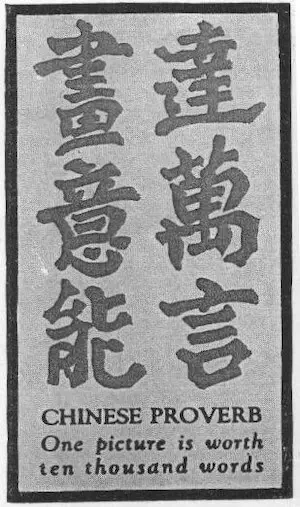Forward & Credits
Have you ever wondered where the saying ‘a picture paints a thousand words’ comes from? I didn’t either, not until I came across an article on the subject as posted to www.phrases.org.uk
______________________________________________________________________________________________________________
A Picture Paints a Thousand Words
The phrase a picture paints a thousand words emerged in the USA in the early part of the 20th century. Its introduction is widely attributed to Frederick R. Barnard, who published a piece commending the effectiveness of graphics in advertising with the title “One look is worth a thousand words”, in Printer’s Ink, December 1921. Barnard claimed the source of the phrase to be oriental by adding the text “so said a famous Japanese philosopher, and he was right”.
Printer’s Ink printed another form of the phrase in March 1927, this time suggesting a Chinese origin:

The arbitrary escalation from ‘one thousand’ to ‘ten thousand’ and the switching from Japan to China as the source leads us to smell a rat with this derivation. In fact, Barnard didn’t introduce the phrase – his only contribution was the incorrect suggestion that the country of origin was Japan or China. This has led to another popular belief about the phrase, i.e. that it was coined by Confucius. It might fit the Chinese-sounding ‘Confucius he say’ style, but the Chinese derivation was pure invention.
Prior To Photography
Many things had been thought to be ‘worth ten thousand words’ well before pictures got in on the act. For example:
– The Works of Mr. James Thomson, 1802.
– The Trust: A Comedy, in Five Acts, 1808.
– The American Journal of Education, 1858.
The idea that a picture can convey what might take many words to express was voiced by a character in Ivan S. Turgenev’s novel Fathers and Sons, 1862:
A similar idea was seen very widely in the USA from the early 20th century, in adverts for Doan’s Backache Kidney Pills, which included a picture of a man holding his back and the text “Every picture tells a story”.
Neither of the above led directly to ‘a picture is worth a thousand words’. Who it was that married the ‘worth ten thousand words’ with ‘picture’ isn’t known, but we do know that the phrase is American in origin. It began to be used quite frequently in the US press from around the 1920s onward. The earliest example that I can find is from the text of an instructional talk given by the newspaper editor Arthur Brisbane to the Syracuse Advertising Men’s Club, in March 1911:
______________________________________________________________________________________________________________
